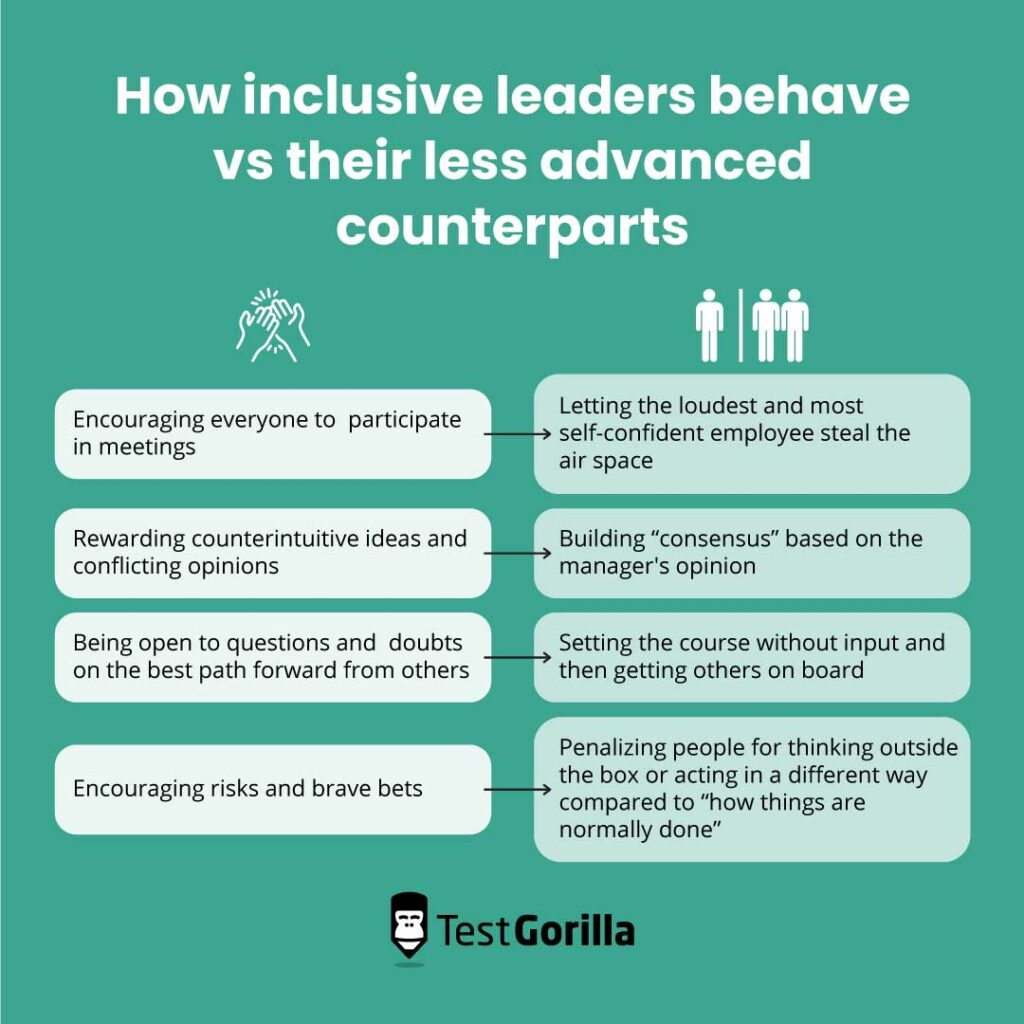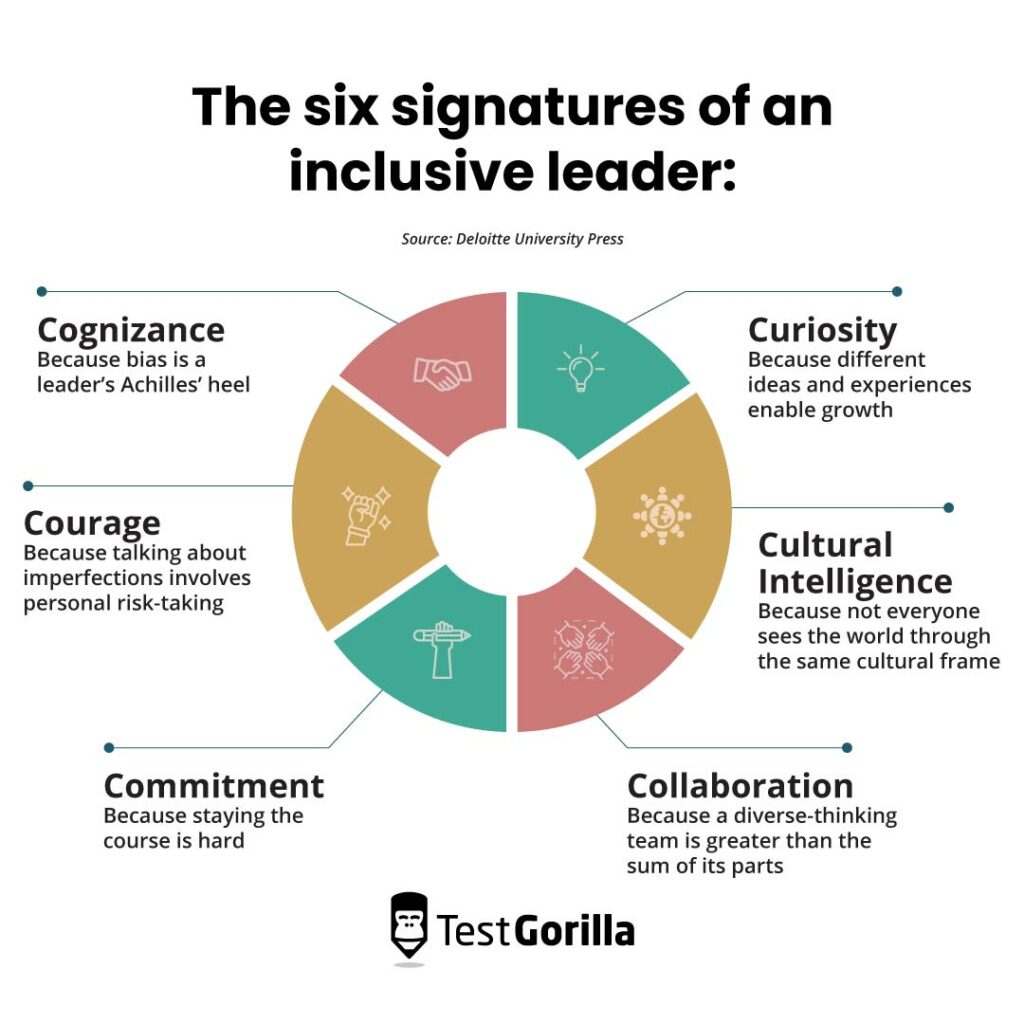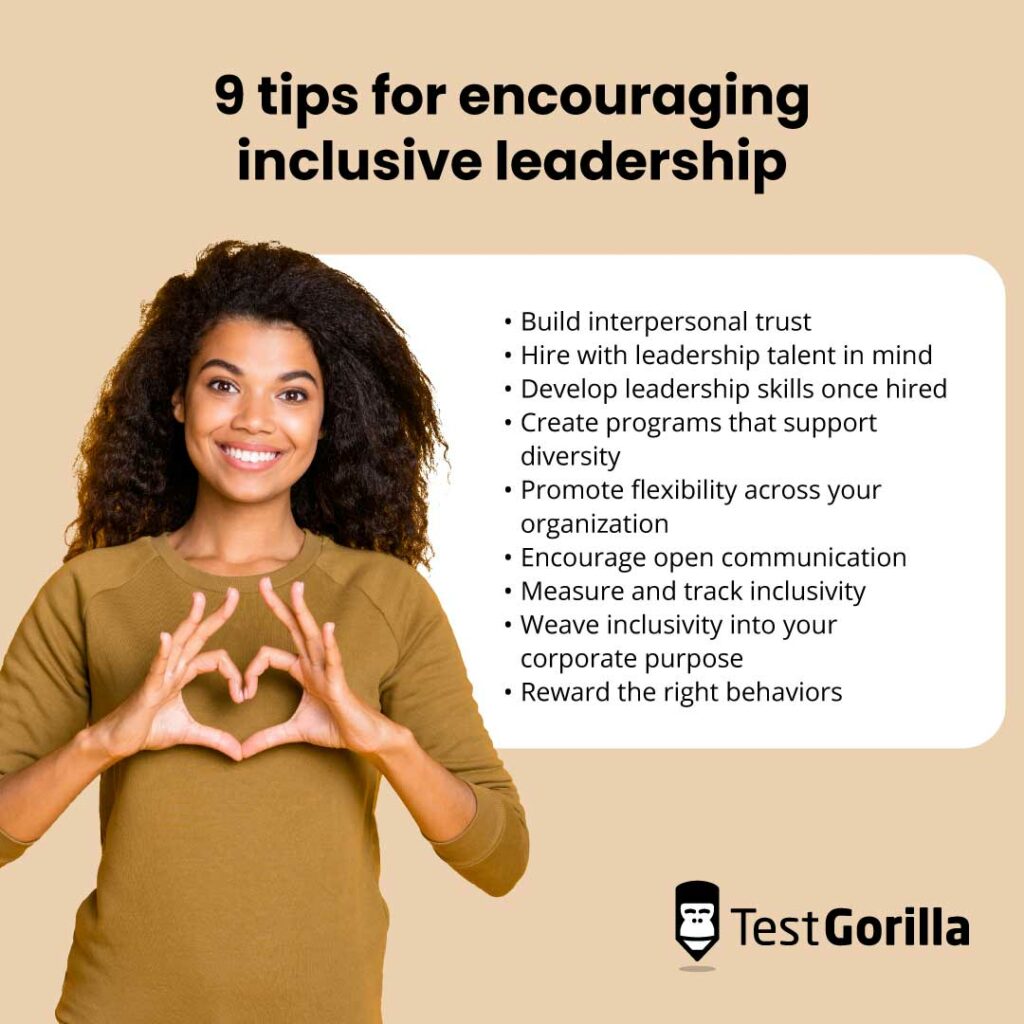Ensuring employees feel like they belong is no easy feat for employers managing a diverse labor force.
Large or small, remote or in-person, businesses of all kinds are struggling to meet the personal needs of their workers in ways that create productive and engaged employees.
Companies are throwing money at diversity initiatives, investing in countless tools and technologies, and considering new flexible working policies – all with the goal of building a dynamic workforce.
While these efforts are helping, many employers are overlooking basic blocking and tackling, forgetting about the importance of managing and leading employees in a manner that recognizes and appreciates divergent talents and different perspectives.
In other words… encouraging an inclusive leadership style within their ranks.
Inclusive leadership isn’t just about warm feelings on the team because research shows that the businesses benefit, too. From attracting better talent to more effective corporate decision-making, people and companies fare better when leaders manage with inclusivity in mind.
To explore this important topic, we’ve created a guide for employers to develop inclusive leaders at their firm so their employees and bottom line can benefit.
Making sure your talent flourishes is a core value for us at TestGorilla, which is why concepts like inclusive leadership permeate all of our pre-employment skills assessments (including our Leadership and People Management test).
So with that said, let’s dive in!
Table of contents
What is inclusive leadership?
Here’s a simple inclusive leadership definition:
Inclusive leadership is a style of leadership that emphasizes an organizational culture where everyone feels valued, respected, and empowered to contribute to the success of the organization.
Inclusive leaders recognize and embrace the diversity of background, experience, and viewpoints on their team by promoting collaboration and fostering a sense of belonging.
Inclusive leadership celebrates differences and ensures everyone has an equal opportunity to participate and succeed with no favoritism. This management style is accepting of diversity as expressed in many different forms, such as:
Race
Ethnicity
Gender
Age
Sexual orientation
Religion
Intellectual approach
Career background
Personality type
Inclusive leaders recognize their human-based approach doesn’t just create more cohesive cultures but also fosters a workforce that produces the most creative and impactful work possible.
Inclusive leadership harnesses the power of inclusivity to promote open communication, robust decision-making, and innovation – outcomes impossible with hierarchical, top-down management.
To bring this point to life, let’s contrast how inclusive leaders might behave versus their less advanced counterparts.
Inclusive leadership looks like… | Outdated leadership looks like… |
Encouraging everyone to participate in meetings | Letting the loudest and most self-confident employee steal the air space |
Rewarding counterintuitive ideas and conflicting opinions | Building “consensus” based on the manager’s opinion |
Being open to questions and doubts on the best path forward from others | Setting the course without input and then getting others on board |
Encouraging risks and brave bets | Penalizing people for thinking outside the box or acting in a different way compared to “how things are normally done” |
The former creates bold and positive outcomes, and the latter creates more of the same old outcomes as always. Boring and backward.
Companies hiring traditional leaders are bound to be left behind by more open-minded competitors. Let’s expand on this point and dig into why and how inclusive leadership matters in today’s business world.
Why is inclusive leadership so important for HR teams and organizations as a whole?
It might be easy to manage a monocultural team that thinks and acts alike, but who are we kidding – where do those exist anymore? At least not at the companies thriving and adapting to modern times!
Managing multicultural teams on the other hand? Difficult, but vital to stay ahead of emerging trends and continue attracting the best talent.
As we see it, inclusive leadership is the cornerstone for companies that want to be on the right side of history and growth opportunities in their industry.
But don’t just take our word for it. Take a look at these studies showing how inclusive leadership and diversity help HR teams and organizations to:
Create an attractive place to work and hire competitive talent – Deloitte found that 72% of workers would leave or consider leaving an organization for a more inclusive one.[1]
Drive better financial outcomes – McKinsey found the most diverse companies are 35% more likely to have industry-beating returns.[2]
Grow faster – BCG found diverse management teams saw revenue growth 19% higher than homogenous teams.[3]
Engage a younger workforce – A different Deloitte study found 83% of millennials are actively engaged when they believe they are working in an inclusive culture.[4]
Whether it’s industry-leading financial metrics or a happier and more productive workforce, inclusive leadership benefits everyone involved.
So now that we’ve covered the upsides of incorporating inclusivity, it’s worth talking about the actions and decisions inclusive leaders at your company should be making.
What behaviors define inclusive leadership?
The 6 C’s of inclusive leadership is a helpful framework in management circles used to define the signature traits inclusive leaders possess.
They are:
Courage
Commitment
Cognizance
Curiosity
Cultural intelligence
Collaboration
These are useful characteristics to keep in mind when developing leadership skills in your workplace. The 6 C’s can be used as a training structure or feedback mechanism to reward and improve inclusivity at your company.
Let’s look at how these competencies display themselves in leadership situations, including some inclusive leadership examples from innovative companies across various industries.
Courage
Inclusive leaders need to have the courage to challenge the status quo and be vulnerable about their strengths and shortcomings.
By embracing their own imperfections, leaders create a safe space for employees to be open about the difficulties they face and the problems they notice.
This psychological safety is important for employees to live up to their full potential at work.
Imagine a world where insiders can provide feedback about risks and hazards within a company without fear of retribution. Is it too much to wonder whether inclusive leadership can prevent the next financial crisis in this way?
Commitment
Inclusive leaders are committed to diversity and inclusion over the long term because they see the benefits but recognize the uphill battle to effect real change.
Improving diversity and inclusivity at any company takes intention and investment over many years.
For example, take J.P. Morgan, which committed to improving the representation of Black, Hispanic, and female employees in their senior leadership roles in 2017.
Only after years of expanded recruitment efforts, bias training, and diversity councils did the company note a 50% increase in the number of Black professionals in senior ranks.
While improving diversity might not be the easy thing to do in the short run, it’s the right thing to do for your people and business success in the end.
Cognizance (of bias)
Inclusive leaders are mindful of their own personal biases as well as the biases inherent in the structure or actions of their company.
Leaders who care about inclusivity seek to uncover their own biases and blind spots while encouraging team members to conduct similar exercises. Being aware of your own shortcomings means you consider those factors to ensure you make better decisions.
In fact, many companies have instituted unconscious bias training in order to help their workforce treat each other and other stakeholders better.
Sephora, a large cosmetics company, rolled out research and training on racial bias to improve the retail experience for people of diverse backgrounds.
When implemented properly, cognizance of bias should carry over into employment and management practices of all kinds, such as hiring decisions or transparent pay practices.
Curiosity
Inclusive leaders keep an open mind and understand that shades of gray should be expected and encouraged because different ideas lead to innovative solutions.
Curiosity is required to build team cultures that are open to continuous learning, feedback, and challenging the status quo.
Curious leaders also seek opportunities to hear diverse perspectives from both their own teams and other teams in the organization.
Cultural intelligence
Inclusive leaders adapt to different cultures and execute plans in different environments and demographics than they are used to.
Cultural intelligence can refer to literal cultural divisions in the case of a multinational company, or refer more abstractly to how diverse teams approach problems in different ways.
You might imagine a technology leader that needs to coordinate work across a nerdy and blunt software engineering team as well as a creative and multifaceted design team. Cultural intelligence is required to bridge the gap effectively.
As with the other traits of inclusivity, this requires companies to make intentional investments.
For example, John Deere took all 68,000 employees in its global workforce through D&I training to create more culturally aware perspectives within their teams.
Collaboration
Inclusive leaders appreciate the value of individual perspectives but also recognize the power of bringing diverse ideas together to create a magnified outcome.
Collaboration is the secret sauce of inclusive leadership that harnesses the power of differing opinions. In this case, 1 plus 1 is much greater than 2.
Inclusive leaders see conflicting ideas as a positive sign they are about to uncover a better solution. They work hard to create an inclusive culture where there are no in-group and out-group dynamics at play so this can happen.
How to apply and promote inclusive leadership in your organization
You know what inclusive leadership looks like. You know why it is important for companies to develop for the benefit of your employees and your business growth.
So how do you go about engendering inclusive leadership within your organization? What practices, policies, or changes can you implement to ensure every employee leads with inclusivity in mind?
You need to be a role model for your team. Your employees or direct reports won’t have an incentive to work on inclusive leadership skills if their own leader is lacking them.
It might seem like some of the traits that go along with inclusive leadership like empathy, humility, and self-awareness are difficult to teach, but inclusive leadership is absolutely a skill you can develop with the right training and support.
Investments from the early stages of adopting skills-based hiring and upskilling employees to building inclusive management practices into your corporate ethos are all required to create a diverse, inclusive, and successful workforce.
Here are nine effective ways to build and encourage inclusive leadership across your organization.
9 tips for encouraging inclusive leadership
Ideas to promote inclusive leadership | What this means, in a nutshell |
Build interpersonal trust | Create a culture of reliability, collaboration, and respect |
Hire with leadership talent in mind | Find naturally skilled leaders during the hiring process |
Develop leadership skills once hired | Continue to invest in inclusive leadership training to build skills for employees inside your company |
Create programs that support diversity | Invest in diversity and inclusion training and create employee groups centered on diversity |
Promote flexibility across your organization | Encourage flexible work policies and environments |
Encourage open communication | Foster two-way feedback and open-minded discussions |
Measure and track inclusivity | Track success with KPIs |
Weave inclusivity into your corporate purpose | Relate inclusive leadership to your company’s mission |
Reward the right behaviors (and discourage the wrong ones) | Provide recognition and awards to employees embodying inclusive leadership |
Let’s look at each in more detail.
1. Build interpersonal trust
Trust in the workplace is a critical element for encouraging inclusive leadership – primarily because it’s a prerequisite for others to feel empowered to be inclusive.
In order to harness the benefits of inclusive leadership, team members and managers need to know they are:
Psychologically safe to speak up without fear of negative consequences
Respected and valued so they want to share their opinions
Understood because their coworkers have empathy and appreciation for their unique perspectives
Employers can create a foundation of trust by applying decisions transparently, consistently, and fairly. For example, by sharing corporate goals and progress and being open about compensation and advancement opportunities.
2. Hire with leadership talent in mind
One simple way to promote inclusive leadership within your organization? Hire inclusive leaders in the first place!
When you apply a skills-based approach to the hiring process – one that emphasizes objective aptitude over subjective experience – you can assess leadership skills upfront.
One pre-employment assessment we see almost every employer appreciate, regardless of role, is our Culture Add test, which can help employers find candidates that display behaviors aligned with inclusivity.
3. Develop leadership skills once hired
Of course, not every employee is a leader from day one, and others may need some help saying goodbye to outdated management habits.
For these employees (and really your entire workforce) ongoing training and leadership development is a valuable investment.
You can develop leadership skills through a variety of approaches, including:
Workshops and seminars
Coaching or mentoring
On-the-job training
Regardless of the methods you use, make sure to emphasize inclusive values like empathy, humility, and accountability.
4. Create programs that support diversity
Diversity goes hand in hand with inclusive leadership, but increasing diversity requires long-term investments in formal initiatives.
While there’s no single way to make your company more diverse, we’ve seen many employers succeed by implementing a combination of:
Unconscious bias training
Diverse recruitment requirements
Employee resource groups (for women, LGBTQ+, people of color, and more)
Whatever you do, just know that goals to “improve diversity” or “hire better” aren’t going to cut it. Instead, employers need to create a structure for how they can improve diversity and inclusivity.
5. Promote flexibility across your organization
Flexibility and open-mindedness are core tenets of inclusive leadership styles.
Flexible working policies also create space for employees with different backgrounds and personal situations to contribute to their full abilities.
For example, your company might practice inclusivity by:
Allowing flexible work hours
Encouraging job-sharing or job-shadowing
Solutions like these can help your employees design a work environment that brings out the best in them.
6. Encourage open communication
Actively listening for diverse perspectives and challenging ideas is a hallmark of an inclusive leader.
While this may come easy to some, there are active choices your company can make to encourage open communication.
For example, your organization might:
Make changes to the physical workspace and create open floor plans or get rid of corner offices
Conduct routine employee satisfaction surveys
Schedule 360-degree evaluations and feedback sessions
All of these options can improve communication and promote an equitable, inclusive workplace.
7. Measure and track inclusivity
What doesn’t get measured doesn’t get managed, and diversity and inclusion is no different.
Employers who are serious about applying an inclusive leadership style throughout their organization need to determine what success looks like.
This might mean setting KPIs for the makeup of your diverse workforce, tracking attrition rates, or measuring satisfaction through ongoing surveys.
The important thing is to set measurable goals to gather data on the perception and reality of inclusivity across your company.
8. Weave inclusivity into your corporate purpose
A good way to ensure inclusive leadership practices remain at the core of your organization is to link it directly with your corporate purpose.
The purpose of your company encapsulates more than motives about profit and speaks to the impact you hope to have on the world.
Help your employees and leaders understand how a mission to “be an innovative healthcare company providing access to low-income communities” requires inclusive leadership values.
That way, there is no question about the actions you expect all workers to take in order to achieve the desired outcome.
9. Reward the right behaviors (and discourage the wrong ones)
Lastly, one tip any organization can use is to reinforce behaviors that embody inclusive leadership practices and penalize inappropriate conduct.
On the positive end, you can build a culture of inclusivity by rewarding actions and activities that foster teamwork and respect.
This might be accomplished through the use of spot awards or through internal promotions and career advancement for inclusive leaders.
However, don’t overlook the bad behavior either. Both sides of the equation are necessary, unfortunately, since employees of all kinds continue to face discrimination and harassment.
Inclusive leadership helps companies attract and retain talent
By prioritizing inclusivity in their management style, employers can create a more welcoming and collaborative workplace where everyone can thrive and contribute to the organization’s success.
Inclusive leaders play an important role by empowering team members and responding to the changing needs of the business in ways that stay true to core values of respect and open-mindedness.
But effective leadership styles transcend the culture on the inside of a corporation and greatly influence a company’s ability to hire (and then retain) great employees.
Without inclusive leaders, organizations are unlikely to appeal to young and talented workers and are even less likely to hold onto talent from underrepresented groups who might not see themselves in their managers.
If your business is ready to be a preeminent employer of the future, embrace inclusive leadership values and hire free of bias and exclusion with pre-employment skills assessments.
Sources
Smith, Christie; Turner, Stephanie. (December 2015). “The Radical Transformation of Diversity and Inclusion: The Millennial Influence”. Deloitte University. Retrieved April 5, 2023. https://www2.deloitte.com/content/dam/Deloitte/us/Documents/about-deloitte/us-inclus-millennial-influence-120215.pdf
Hunt, Vivian; Layton, Dennis; Prince, Sara. (January 1, 2015). “Why diversity matters”. McKinsey & Company. Retrieved April 5, 2023. https://www.mckinsey.com/capabilities/people-and-organizational-performance/our-insights/why-diversity-matters
Lorenzo, Rocío; Voigt, Nicole; Tsusaka, Miki; Krentz, Matt; Abouzahr, Katie. (January 23, 2018). “How Diverse Leadership Teams Boost Innovation”. Boston Consulting Group. Retrieved April 5, 2023. https://www.bcg.com/publications/2018/how-diverse-leadership-teams-boost-innovation
“Inclusion pulse survey”. (2017). Deloitte University. Retrieved April 5, 2023. https://www2.deloitte.com/content/dam/Deloitte/us/Documents/about-deloitte/us-about-deloitte-inclusion-survey.pdf
Related posts
Hire the best candidates with TestGorilla
Create pre-employment assessments in minutes to screen candidates, save time, and hire the best talent.
Latest posts
The best advice in pre-employment testing, in your inbox.
No spam. Unsubscribe at any time.

Hire the best. No bias. No stress.
Our screening tests identify the best candidates and make your hiring decisions faster, easier, and bias-free.
Free resources
This checklist covers key features you should look for when choosing a skills testing platform
This resource will help you develop an onboarding checklist for new hires.
How to assess your candidates' attention to detail.
Learn how to get human resources certified through HRCI or SHRM.
Learn how you can improve the level of talent at your company.
Learn how CapitalT reduced hiring bias with online skills assessments.
Learn how to make the resume process more efficient and more effective.
Improve your hiring strategy with these 7 critical recruitment metrics.
Learn how Sukhi decreased time spent reviewing resumes by 83%!
Hire more efficiently with these hacks that 99% of recruiters aren't using.
Make a business case for diversity and inclusion initiatives with this data.






















